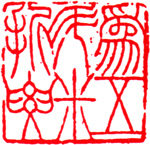


 Seal by Huang Yi
Seal by Huang Yi
 Seal by Wu Rang Zhi
Seal by Wu Rang Zhi
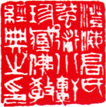
 Seat by Wu Cangshou
Seat by Wu Cangshou
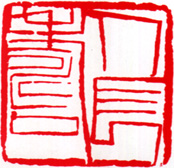


 Imperial Signets
Imperial Signets
Seal carving is called Zhuan ke in Chinese, zhuan being the style of character used for this craft. Since ancient times, seal characters have been used and it has become an exclusively Chinese art form.
Some three thousand years ago, in the Yin Dynasty ((1066-16B. C.), people used chisels to engrave characters on tortoise-shell and animal bones. Seals appeared during the Spring and Autumn Period and the Warring States Period and they were known as yinxi (imperial signets). They were made of jade or bronze and used by emperors as proof in issuing orders. Sometimes, this seal was made in the form of a recumbent tiger split into two identical halves which could be separated and then pieced together. This credential was called a hufu (tiger tally) and was used in deploying forces and generals, In 257 B. C., Xingling, the prince of Wei, stole the hufu from his father, the king of Wei, after which he manoeuvred an army of one hundred thousand men and horses to defeat the troops of the Qin kingdom thus saving the Zhao kingdom, It is for this reason that in his book Sho Wen Jiezi (The Interpretation of the Text and the Analysis of Chinese Characters), Xushen (158-147 B. C.) wrote "in the seals lies the power of great men",
After China's unification under Emperor Qin Shi Huang, it was decreed that only the emperor had the rightto use the xi (imperial signet) which was made of jade and the base of which was engraved with small seal characters delicately and rigorously executed.
Use of seals became popular in the Han Dynasty, They were no longer made only of jade but also of gold, silver and copper. Signets which carried the character xi were used at that time by the emperor, empress and noblemen, The seals of the high-ranking officials were called yin, and zhang was the name given to the generals' seals. Hierarchical distinctions were apparent in the quality of the materials and the colour of the seal's ribbon. The base could be made from jade, gold or copper; the handle could be shaped like a tiger, a tortoise or a nose; the ribbon could be purple, green, black or yellow and so on.
During the Han Dynasty, most of the seals were cast in moulds, except for military emergencies when they were chiselled in order to save time. These seals were called "emergency seals". The characters used for carving in the Han Dynasty were different from the small seal characters used in the Qin Dynasty. The rectilinear and robustly formed characters following the Miao Zhuan style were adopted as a model by subsequent engravers. Chen Honghou, an engraver in the Qin Dynasty, claimed that "to learn the art of seal carving, the engravers adopted the Han artists as their masters and they pursued the tenet that the spirit and the movements of the hand should combine by hard work and spirit in their search for perfection and only in this is it possible to transform a signet into a work of art".
The official seals of the Tang Dynasty did not feature the Miao Zhuan nor the intagliated characters but rather Jiu Die Zhuan (nine-curve characters) which are distinguished by intricate curves and lines which are rather inexpressive and difficult to decipher.
During the Yuan Dynasty, Mongol characters, amongst others, were used in official signets so as to outline the curvature of the characters.
Jiu Die Zhuan (nine-curve characters) remained in sole use during the Ming Dynasty whereas in the Qin Dynasty the official seals used along the borders were mostly bilingual, engraved in Chinese as well as in Manchu characters.
The official seals used in all the dynasties revealed the hierarchical rank of the user. As for private seals, they could be carved to one's liking as long as the character xi was not used. This artistic freedom allowed an unmatched advance in the art of carving non-official seals as well as the contents and the form of the inscribed character, thus turning it into one of the most popular art forms in China.
Gradually, seals came to be more widely used. There were seals with the name of a person, with his signature, seals used for correspondence, for signing calligraphy and paintings, seals with characters expressing luck, seals with pseudonyms, with iterary phrases, collector's seals and so the list goes on.
The themes of these "literary" seals were extraordinarily rich, ranging from proverbs and aphorisms to poems and sayings which often expressed the feelings, thoughts and attitudes of their authors or owners with regard to society.
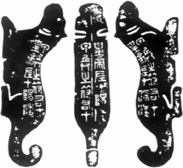 1 Hufu - credential for generals, used for deploying military forces and generals.
1 Hufu - credential for generals, used for deploying military forces and generals.
 2 Seal in the shape of a tiger
2 Seal in the shape of a tiger
 3 Seal in the shape of a tortoise
3 Seal in the shape of a tortoise
 4 Seal in the shape of a nose
4 Seal in the shape of a nose
 5 Seal used for an emergency
5 Seal used for an emergency
Amongst the enormous variety of antique seals there is one outstandingly beautiful kind: the seals with figurines. Generally speaking, these seals were not used to attest documents. There were two types: one shows human figures or animals engaged in different social activities such as hunting, dancing, etc.. The other type features character inscriptions of family names, dragons, tigers or the four souls. The figurine style made use of lively exaggeration and was highly regarded for its unique position in the field of seal carving.
After the Tang Dynasty, there was a fashion for collecting seals as well as paintings and calligraphy. This changed the habitual use of the signet in the Qing and the Han Dynasties. The use of seals split into two areas: a practical function and an ornamental function.
In the Sung Dynasty, Emperor Song Huizong compiled the first book on seals, titled: The History of the Xuanhe Signets and so seals officially entered the field of art and formed a tripartite alliance with painting and calligraphy.
By the end of the Yuan Dynasty, Wang Mian had started to carve seals from hua ru stone which belongs to the Qing Tian family of stones (chemical composition A12, Si4, O10, OH20). This move gave scholars the chance to make their own engravings as this material was far easier to come by. Due to the generalization of seals during the Ming and Ying Dynasties several schools of carving appeared.
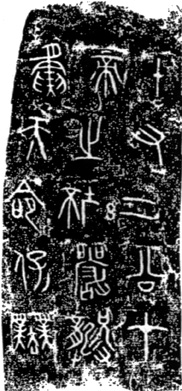 Zhuan
Zhuan
 Jiu Die Zhuan (nine fold characters)
Jiu Die Zhuan (nine fold characters)

 Xiao Xing Yin (Seals with figurines)
Xiao Xing Yin (Seals with figurines)
 Seal by Wen Peng
Seal by Wen Peng
 Seal by Hen Zhen
Seal by Hen Zhen
During the middle and later period of the Ming Dynasty, Wang Peng (1498-1573), painter and engraver, was considered the father of the school of seal carving. He worked originally with marble and later on with soap-stone, Wang Peng was skilled in liushu (the six categories of Chinese characters) and possessed extensive knowledge of philology. He advocated that the norm for seal carving should be based on liushu. He engraved in zhuwen (characters on a seal carved in relief), a vigorous, pure and rectilinear style, and in baiwen (an intagliated character), a clear and neat style. The greatest merit of this engraver lies in the fact that he absorbed the Han style which reinforced feelings and tenderness, delicacy and elegance, whilst purifying the curves and bends that were featured during the Sung and Yuan Dynasties,
He Zhen studied Weng Peng and assimilated the merits of the Han method, producing a simple and concise style characterized by clear lines and incisions carved with a chisel. Thus new life was breathed into the art of seal carving.
Cheng Sui, Ba Weizu, Hu Tang and Wang Zhaolong did not only take over from He Zhen but they also reformed his style. Their achievements were mainly reflected in their study of the Qing and Han style and they developed a new form. They were known as the "School of Wan". This school was followed by another great school called "Zhe" whose founder was Ding Jing (1695-1765). He studied the characteristics of the seals which appeared after the Qin and Han Dynasties. Ding, a master in handling the chisel, refined his work to a solemn, elegant and calm style. In engraving baiwen, he preferred to make tiny incisions with his chisel. Ding Jing originally came from Zhe Jiang Province which explains why his school was known as "Zhe".
His method of seal carving became a fad of the time and it was fashionable to imitate his style. Outstanding followers of the school were Jiang Ren, Huang Yi, Xi Gang, Chen Hong Shou, Zhao Zishen and Qian Song. Although all of them followed Ding Jing's style, each had his own particular characteristics. They were known as "the eight masters of Xileng".
A little later than Ding Jing, Deng Shiru appeared (1743-1805) and he created his own new style. He combined shiguwen (the inscription round a cylindrical stone) with hanbeizhuan (a calligraphic style used on Han Dynasty gravestones). This unique style was characterized by strength, elegance and variety and thus created the "School of Deng".
During the second half of the Qin Dynasty, there were innumerable carving masters of whom the most outstanding ones were Wu Rangsi, Shao Ziqian, Wu Changshuo and Hang Shiling.
Wu Rangsi (1799-1870), Deng Shiru's student, adopted his method of carving in a light and superficial way, barely using the edge of his knife. While carving he kept his wrist flexible but his fingers were firm. His skill was such that he made more than ten thousand seals during the course of his life and his work had a major influence.
Zhao Ziqian (1829 - 1884) learned his craft first from Ding Jing and then from Deng Shiru and Wu Rangsi. However, he created his own style by making extensive use of archaeological discoveries and characters used for inscriptions. He embellished his figures with sculptured figures, landscapes and so on.
Wu Changshuo (1844-1927) was inspired by the inscriptions found on nifeng (a clay stamp used to seal official and private documents and correspondence) and wadang (a semi-circular clay tile used in roof decoration). His work, simple and unassuming, revealed both skill and uniformity, full of spirit and energy, natural and naive. His work was impressionistic and through carving seals he reached a new dimension never before achieved by his predecessors.
Huang Shiling (1849-1908) was also a student of Deng Shiru and was later influenced by Zhao Ziquan. He took his inspiration from Han Dynasty tiles and bronze objects from the Xia, Shang and Zhou Dynasties. He did not confine himself to the Ming and Qin schools and in fact he incorporated the best of everything by imitating Han to create his own style. In this way he founded the "School of Yishan".
After Wu Changshou and Huang Shiling, the most important seal carver was Qi Baishi (1863-1957) who started a separate school, He developed a technique consisting of swift and deep incisions. He usually carved characters in relief with no more than a single fast incision which he usually left without giving it any finishing touches. His style, free from the influence of his predecessors, was characterized by determined, spontaneous and innovative incisions. He is one of the great masters of modern time.
All of these great masters have developed their techniques to a tremendous degree. The process of carving the seal involves three main steps which are calligraphy, artistic composition and the use of the chisel. Calligraphy is at the root of the value of the seal, therefore it is necessary to have a profound knowledge of the structure and evolution of Chinese characters so as to execute the seal correctly. Otherwise, it will be a failure. The carver must be very familiar with Chinese characters from different dynasties and they cannot be selected at random. The layout of the characters should reflect the space between them and give a balance between simplicity and complexity.
There are two techniques as regards cutting the seal. No matter what the method, nimbleness and speed are required so as to obtain harmony between contents and form. Apart from the main part of the seal, there are the edges, handle and material used, all of which are integral to the seal. When these elements are perfectly combined the result is a perfect work of art.
The sides of the seal resemble the inscriptions on a painting or a calligraphy scroll; the contents vary but usually include the signature of the author, the date and place where it was made, an explanation of the contents of the seal, the author's opinion and sometimes some verses or proverbs are engraved on it for mutual encouragement between friends. There are laterally engraved characters in all the traditional styles.
The handle of the seal is pierced. Originally, a ribbon or string was laced through the hole to make it easy to carry. After stone seals appeared, the handle underwent several developments displaying new forms which can be classified into five groups: biniu (nose-shaped handle); waniu (handle in the form of a semi-cylindrical file); zhuxinniu (tablet-shaped handle); renwuniu (handle in the form of a human figure); dongwuxiniu (handle in the form of an animal.)
The importance of the choice of material for a good engraving should be mentioned. It could be said that the quality of the stone is the key to successful seal cutting. There are many stones used in carving seals which are peculiar to China of which tianhuang and jiuxe are the most precious. The former is considered to be the "king" of stones as it combines six essential qualities: delicacy, transparency, suavity, solidity and softness.
These stones are not only expensive because of their characteristics but also because they are extremely rare and are highly appreciated.
Seals used for paintings and calligraphy also have to harmonize with the colouring in order to add perfection and beauty to the overall effect.
The art of carving seals is a rare pearl in the treasurebox of world art.

Seal by Deng Shi Ru


Seal by Dinjing.
* Lecturer in Chinese painting at the Beijing University of Fine Arts; member of the Beijing Association of Fine Arts and the Chinese Calligraphy Association; designer for Central Television in the People's Republic of China.
start p. 77
end p.